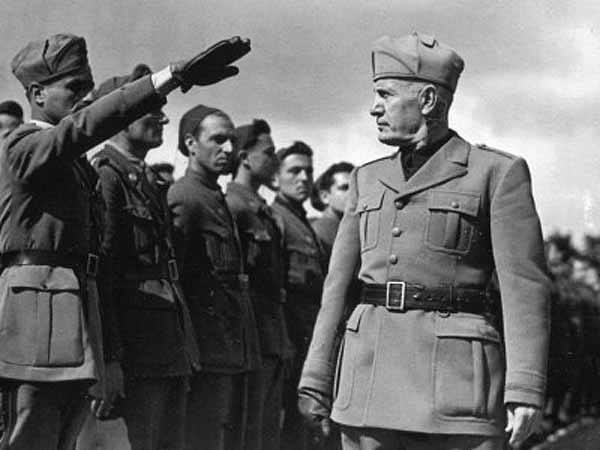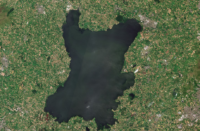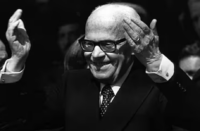When Mussolini’s Italy invaded Ethiopia in 1935, most nations did little to help the Ethiopians. Britain and France, for example, were still appeasing Fascism in hopes it would head east and bring the free market back to the Soviet Union. Anthony Eden, then minister for the League of Nations affairs, did propose cutting off the Italian oil supply which was needed for the war. Instead, the League put on sanctions that were for things Italy either didn’t need for the war or had an abundance of already.1 The League of Nations policy of not supplying guns to warring nations also meant that the far better-equipped Italy was able to steamroll the far weaker Ethiopia with its poison gas, modern planes and modern tanks. All of which Ethiopia lacked.
The invasion was under the guise of Mussolini’s ambitions of restoring the Roman Empire. Already, since before World War I, Italy had obtained land in Libya, Eritrea and Somalia. Although Ethiopia was never a part of the Roman Empire it was important in boosting Mussolini’s popularity at home. It was a brutal conquest where nearly 300,000 Ethiopians were killed.
In America, the African-American community had deep sympathy for Ethiopia. Not only was it one of only two African countries never fully colonised by European powers, but it was also seen as a defender of Africans after it beat Italy in the first Italian-Ethiopian war in 1896. The mass mobilisation against the Italo-Ethiopian war was a great show of working-class solidarity in the African-American community. As Roi Ottley said: “I know of no other event in recent times that has stirred the rank and file of Negroes more than the Italo-Ethiopian war.”2
The main organisations in America that protested the Italian aggression were the National Association for the Advancement of colored people (NAACP), The Communist Party of the United States of America (CPUSA) and the Provisional Committee for the Defence of Ethiopia (PCDE) which was proposed by the Harlem section of the Communist Party.
The PCDE was the main unified driving force behind the boycotts of Italian goods and businesses in the United States as well as getting medical supplies sent to help the Ethiopians. The organisation was also keen to show that this opposition to the Italian invasion should not extend to Italian-Americans themselves as many left-wing Italian-Americans were members of the organisation.3
Samuel Daniels of the Pan-African Reconstruction Association (PARA) toured American cities to try to get volunteers to fight for Ethiopia. Although hundreds wanted to volunteer to fight, very few made it to Ethiopia as it was illegal at that time for Americans to fight for a foreign nation and any citizen accepting a commission to serve in Ethiopia’s military could be fined up to $2,000 and imprisoned for up to three years.4
The other problems with African-Americans enlisting to fight for Ethiopia were that Emperor Haile Selassie did not accept foreign volunteers and the cost of getting to Ethiopia from America was incredibly high. African Americans also tried to claim they had Ethiopian ancestry to circumnavigate the ban but this too didn’t work very well. However, it would be incorrect to say that Ethiopia had no foreign volunteers as the most famous volunteers to fight for Ethiopia were Hubert Julian and John Robinson. Both were aviators and both would return to Ethiopia a few years later to help liberate it in the East African Campaign.
Unfortunately, by 1937 Ethiopia was entirely under the control of Italy. The international community moved on as they were more worried about Hitler’s violations of the Treaty of Versailles than of an African nation that no European power cared about in the first place.
The importance of studying the African-American response to the Italian-Ethiopian war is clear as we can see very clear parallels with the current genocide in Gaza. There we see another fascist state claiming the legacy of a nation that hasn’t existed for centuries to mass murder innocent civilians while dehumanising them, all while the international community does nothing. It is once again being left up to the working class to mobilise to their defence, to protest and to boycott. In the words of Emperor Haile Selassie, “It is us today. It will be you tomorrow.”
1 Leckie, R. (1987) in Delivered from Evil: Saga of World War Two. New York, New York: Harper & Row, p. 63.
2 Adi, Hakim (2023) in Pan-Africanism: A History . New York, New York : 1804 Books, p. 128.
3 Ben-Ghiat, R. (2020c) When fascist aggression in Ethiopia sparked a movement of Black solidarity, The Washington Post. Available at: https://www.washingtonpost.com/outlook/2020/08/03/when-fascist-aggression-ethiopia-sparked-movement-black-solidarity/ (Accessed: 25 February 2024).
4 Meriwether, J.H. (2002) in Proudly We Can Be Africans: Black Americans and Africa, 1935-1961. London : The University of North Carolina Press, p. 45.






